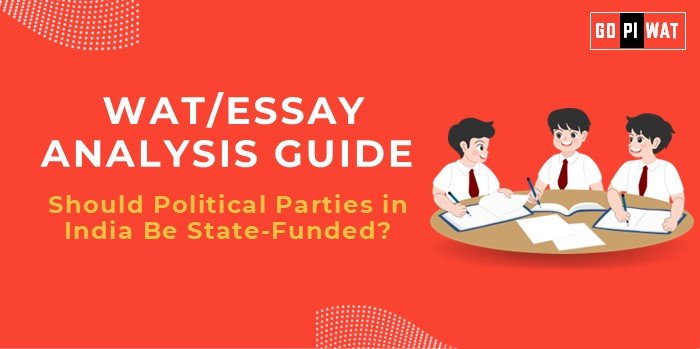🖋️ Written Ability Test/Essay Analysis Guide: Should Political Parties in India Be State-Funded?
🌟 Understanding the Importance of the Topic
Political funding significantly influences the integrity of elections and governance. For B-school aspirants, this topic requires critical thinking on policy design, fiscal responsibility, and ethical governance—skills crucial for leadership roles in public and private sectors.
📝 Effective Planning and Writing
- Time Allocation:
- ⏳ Planning: 5 minutes
- ✍️ Writing: 20 minutes
- 🔍 Review: 5 minutes
- Structure:
- 📜 Introduction: 60-70 words
- 📖 Body: 350-375 words
- 📝 Conclusion: 60-70 words
🎯 Introduction Techniques for Essays
- Contrast Approach:
“While Indian elections engage millions of voters, the opaque funding mechanisms raise concerns about the fairness and accountability of political processes.”
- Solution-Based Introduction:
“State funding of political parties could revolutionize Indian elections by curbing corruption, ensuring transparency, and creating a level playing field.”
🔍 Structuring the Essay Body
- Achievements:
- ✅ Transparency Improvements: Germany’s model shows that state funding can improve transparency and reduce dependency on private donors.
- ⚖️ Fair Elections: In India, state funding could alleviate reliance on opaque funding channels and encourage fairer elections.
- Challenges:
- 💰 Ethical Concerns: Questions arise regarding the use of taxpayer money for political campaigns.
- ⚠️ Risk of Misuse: Funds could be diverted or misused without stringent monitoring.
- 📊 Implementation Issues: Ensuring equitable distribution of funds without bias poses logistical challenges.
- Future Outlook:
- 🗳️ Gradual Implementation: Introduce partial state funding, starting with subsidies for smaller parties.
- 💻 Digital Tools: Use digital platforms to track and audit party expenditures for accountability.
- 📢 Voter Education: Campaigns to educate voters about the benefits of state-funded elections are essential.
💡 Concluding Effectively
- Balanced Perspective:
“State funding, though not a panacea, offers a promising avenue to democratize elections if implemented with strong safeguards and public trust.”
- Global Comparison:
“Drawing from Germany’s state funding model, India can blend transparency measures with financial support to improve electoral fairness.”
📊 Analyzing Successes and Shortcomings
- Achievements:
- ✔️ Reduces reliance on private donors, curbing undue corporate influence.
- 🌟 Encourages smaller parties to participate, fostering competition.
- Challenges:
- 📉 Voter mistrust in using public funds for political purposes.
- ⚖️ Absence of stringent laws to ensure proper utilization of funds.
- Global Context:
- 🇩🇪 Germany’s mixed funding model balances state support with mandatory transparency measures.
🚀 Recommendations for Sustainable Progress
- 🔍 Transparency Mandates: Enact laws to ensure regular audits and public disclosure of fund usage.
- 📊 Gradual Implementation: Pilot state funding programs with smaller parties before scaling.
- 📢 Public Awareness Campaigns: Increase voter education on the benefits and safeguards of state funding.
📚 Sample Short Essays
- Balanced Perspective:
“State funding is a promising solution to democratize Indian elections but requires careful policy design and public trust to succeed.”
- Solution-Oriented:
“By adopting global best practices, India can implement state funding to ensure fairer elections while safeguarding taxpayers’ interests.”
- Global Comparison:
“Lessons from Germany and the USA highlight the need for robust transparency in any state-funded electoral model.”


